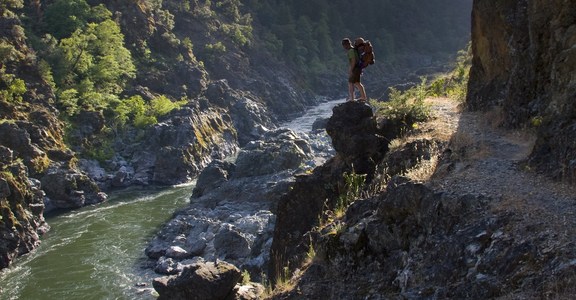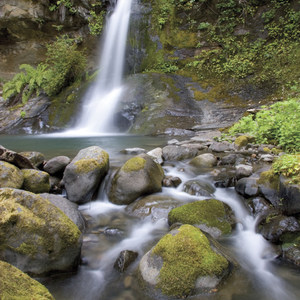Little Queens River Mining History and Overview
In 1886 Matthew Graham, a tireless promoter of the Atlanta region, began developing silver mines in the North Fork of the Boise River drainage near today’s Graham guard station. One of the most direct routes from Atlanta to the new mines was up Little Queens River and over Neinmeyer Creek to the North Fork of the Boise River. As miners rushed to the newest boomtown, a few staked claims at promising outcrops along Little Queens.
Though the Graham Mines were a total bust, several claims in the Little Queens region ended up producing some wealth in the 1900s. The Overlook Mine was active in the teens and twenties, producing thousands of ounces of silver and gold. The Money Prospect produced a few hundred ounces during a similar period, and was later owned by Earl Money, who tinkered away at the property later in the 1940s and 1950s. The Little Queens was active most recently in the 1950s and late 1960s with more than 1000 feet of developed tunnels.
The remnants of the Little Queens Mine (mile 1.2), the Money Prospect and cabin (mile 2.3), and some nice mature forest along the shady side of the river (mile 2.9) are worthwhile day hiking destinations. The second and third crossings of Little Queens River may require wading at medium to high flows. Above the third crossing, the sunny swaths of open meadow can be awash in early to mid-summer wildflowers. This canyon, though pretty, is not nearly as dramatic as other more alpine Sawtooth drainages, and the long hike can start to feel like walking on a treadmill. Note that the Queens and Little Queens drainages burned significantly in 2013. Expect to encounter charred forest, downed trees, altered description, and other effects from the fire.
Browns Lake
The route to Browns Lake follows the old road (now a trail) that extended almost 4 miles up the Little Queens River Canyon to the mines. The lake is one of only three alpine lakes in the Atlanta region that is within day hiking distance from either the Powerplant or Queens River trailheads (Scenic Lake and Leggit Lake are the other two). The total mileage to Browns Lake is actually a bit shorter than to Scenic Lake, which is also accessed from the Little Queens River Trail.
The trail climbs an additional 2.2 miles up Little Queens River from the Scenic Lake junction. It passes through more open grassy slopes interrupted by small islands of trees. The scenery is pretty, but after 8 miles of fairly uniform landscape, hikers will be eager to climb into the alpine cirques surrounding Browns Lake. The potential for sunny, early-season wildflowers along the upper Little Queens River is very good.
The last mile to Browns is short but steep, perhaps second only to the Scenic Lake Trail in terms of trail incline in the Sawtooth Wilderness. The broad basin above the lake offers plenty of interesting terrain to explore after setting up camp.
Wilderness Regulations
Most of the trail lies within the Sawtooth Wilderness. Please observe the following regulations:
• Mountain bikes are not allowed past the wilderness boundary.
• Self administered wilderness permits are required and available at the trailhead.
• Dogs must be on a leash between July 1 and Labor Day.
• Camp 100 feet from trails, lakes and streams.
• Pack out all garbage.
• Human waste should be buried and well disguised in a cat hole 6 to 8 inches deep. Pack out all toilet paper.
• Campfires allowed ONLY in a backcountry pan or fire blanket.
• Campfires are NOT allowed at some lakes and in some drainages in the Sawtooths. Please review the campfire restrictions at individual trailheads.
• Permits required for all stock use in the wilderness. No grazing allowed in the Salmon River watershed (This includes the Alpine Lake drainage).
• No equine stock at Edith Lake. ALL stock prohibited in the Goat Creek and Alpine Creek (Alturas Lake) drainages.
Off-Trail Hiking
The more eroded ridges of Idaho Batholith granite surrounding the lake do not present many obstacles to peak baggers. The south ridge of Browns Peak is a straightforward walk up a sloping talus-covered ridge. The easiest route up Flat Top is via the long, curving north ridge, though other more direct scree slopes on the north face could probably be climbed.
Backpackers willing to tackle more challenging terrain with a load can follow the ridge west of Browns to Triangle Lake. From here, a steep shoulder west of Point 9,302 presents some Class 3+ difficulties to the divide. A steep descent west and then due south deposits hikers in the Scenic Creek basin. This short but challenging route creates a nice loop between the two basins that would otherwise take 6.5 miles of trail walking to connect.
Logistics + Planning
Current Weather: Powered by Dark Sky







Preferable season(s)
Congestion
Parking Pass
Pros
Cons
Trailhead Elevation
Features
Suitable for
Our mission is to inspire adventure with beautiful, comprehensive and waterproof map-based guidebooks. Owner, publisher, and photographer Matt Leidecker, grew up exploring and guiding on the rivers in central Idaho. His award winning Middle Fork of the Salmon River – A Comprehensive Guide is the standard by which other river guidebooks are measured. Printed on virtually indestructible YUPO paper, IRP guides are truly unique all-in-one resources for adventure. Each book is loaded with full-color maps, stunning photographs, and information on the history, geology, and wildflowers. Visit Idaho River Publications to explore our guidebooks to the Rogue River in Oregon and the mountains of Central Idaho.


















Comments
We hiked up to a ridge overlooking Johnson Lake Basin and the views were pretty stunning.
Sign In and share them.